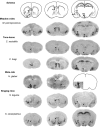Life in groups: the roles of oxytocin in mammalian sociality
- PMID: 24376404
- PMCID: PMC3858648
- DOI: 10.3389/fnbeh.2013.00185
Life in groups: the roles of oxytocin in mammalian sociality
Abstract
In recent decades, scientific understanding of the many roles of oxytocin (OT) in social behavior has advanced tremendously. The focus of this research has been on maternal attachments and reproductive pair-bonds, and much less is known about the substrates of sociality outside of reproductive contexts. It is now apparent that OT influences many aspects of social behavior including recognition, trust, empathy, and other components of the behavioral repertoire of social species. This review provides a comparative perspective on the contributions of OT to life in mammalian social groups. We provide background on the functions of OT in maternal attachments and the early social environment, and give an overview of the role of OT circuitry in support of different mating systems. We then introduce peer relationships in group-living rodents as a means for studying the importance of OT in non-reproductive affiliative behaviors. We review species differences in oxytocin receptor (OTR) distributions in solitary and group-living species of South American tuco-tucos and in African mole-rats, as well as singing mice. We discuss variation in OTR levels with seasonal changes in social behavior in female meadow voles, and the effects of OT manipulations on peer huddling behavior. Finally, we discuss avenues of promise for future investigation, and relate current findings to research in humans and non-human primates. There is growing evidence that OT is involved in social selectivity, including increases in aggression toward social outgroups and decreased huddling with unfamiliar individuals, which may support existing social structures or relationships at the expense of others. OT's effects reach beyond maternal attachment and pair bonds to play a role in affiliative behavior underlying "friendships", organization of broad social structures, and maintenance of established social relationships with individuals or groups.
Keywords: aggression; group living; maternal behavior; oxytocin; pair bond; social behavior; sociality; voles.
Figures

Similar articles
-
Septal oxytocin administration impairs peer affiliation via V1a receptors in female meadow voles.Psychoneuroendocrinology. 2016 Jun;68:156-62. doi: 10.1016/j.psyneuen.2016.02.025. Epub 2016 Feb 26. Psychoneuroendocrinology. 2016. PMID: 26974500 Free PMC article.
-
Oxytocin--a neuropeptide for affiliation: evidence from behavioral, receptor autoradiographic, and comparative studies.Psychoneuroendocrinology. 1992;17(1):3-35. doi: 10.1016/0306-4530(92)90073-g. Psychoneuroendocrinology. 1992. PMID: 1319071 Review.
-
Oxytocin and same-sex social behavior in female meadow voles.Neuroscience. 2010 Aug 25;169(2):665-73. doi: 10.1016/j.neuroscience.2010.05.023. Epub 2010 May 16. Neuroscience. 2010. PMID: 20580660
-
Corticotropin-releasing factor receptor densities vary with photoperiod and sociality.Horm Behav. 2014 Nov;66(5):779-86. doi: 10.1016/j.yhbeh.2014.08.014. Epub 2014 Oct 2. Horm Behav. 2014. PMID: 25284436
-
The Oxytocin-Vasopressin Pathway in the Context of Love and Fear.Front Endocrinol (Lausanne). 2017 Dec 22;8:356. doi: 10.3389/fendo.2017.00356. eCollection 2017. Front Endocrinol (Lausanne). 2017. PMID: 29312146 Free PMC article. Review.
Cited by
-
Host genetics and pathogen species modulate infection-induced changes in social aggregation behaviour.Biol Lett. 2022 Aug;18(8):20220233. doi: 10.1098/rsbl.2022.0233. Epub 2022 Aug 31. Biol Lett. 2022. PMID: 36043302 Free PMC article.
-
Higher oxytocin concentrations occur in subjects who build affiliative relationships with companion robots.iScience. 2023 Nov 23;26(12):108562. doi: 10.1016/j.isci.2023.108562. eCollection 2023 Dec 15. iScience. 2023. PMID: 38162035 Free PMC article.
-
Oxytocin Manipulation Alters Neural Activity in Response to Social Stimuli in Eusocial Naked Mole-Rats.Front Behav Neurosci. 2018 Nov 20;12:272. doi: 10.3389/fnbeh.2018.00272. eCollection 2018. Front Behav Neurosci. 2018. PMID: 30515085 Free PMC article.
-
Helping behavior in prairie voles: A model of empathy and the importance of oxytocin.iScience. 2022 Feb 26;25(4):103991. doi: 10.1016/j.isci.2022.103991. eCollection 2022 Apr 15. iScience. 2022. PMID: 35310938 Free PMC article.
-
Maternal responses to pup calls in a high-cost lactation species.Biol Lett. 2021 Dec;17(12):20210469. doi: 10.1098/rsbl.2021.0469. Epub 2021 Dec 22. Biol Lett. 2021. PMID: 34932922 Free PMC article.
References
-
- Adkins-Regan E. (2005). Hormones and Animal Social Behavior. Princeton, NJ: Princeton University Press
Publication types
LinkOut - more resources
Full Text Sources
Other Literature Sources

